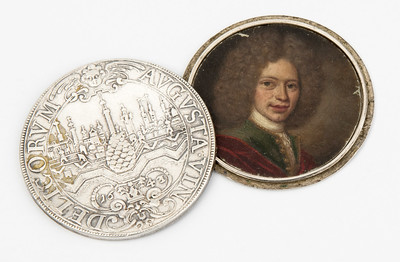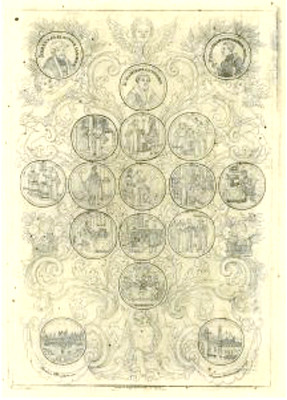
PREV ARTICLE
NEXT ARTICLE
FULL ISSUE
PREV FULL ISSUE
TWO REMARKABLE SCHRAUBTALER ITEMSGil Parsons submitted this write-up of two interesting items in his stock relating to Schraubtalers, or "screw coins", in which the two halves can be screwed apart to reveal items hidden within, such as engraved portraits. Thanks! -Editor
Schraubtaler (literally The coins were filled with painted portraits or scenes, engravings on paper, often presented as a series of images, or occasionally images were engraved on the inner surfaces of the coin itself (as for example in a 1639 piece depicting Swedish king Gustavus Adolphus and his wife.) Content ranged from the political to betrothal portraits and, most especially religious imagery. Not infrequently the coins were exported empty, and could be used for personal messages or even espionage. Alas, the emptiness of most examples seen today is a reflection of the fragility and ephemeral nature of the content. (One notes especially in this context a subgenre known as Glimmerbildschen, in which images were painted on thin slivers of mica.) Seventeenth century Schraubtaler are found from many sources (A 1634 Polish crown of Zygmunt III Vasa with fourteen miniatures inside and an ecus of Louis XIV of 1664 from Bayonne with holy pictures within might serve as examples) but the vast majority of pieces stem from Augsburg, which had both a lengthy tradition of fine metalwork and a concentration of Imperial wealth and power, together with a staunch Protestant tradition which fueled much of the iconography of religious items. The standard reference for the genre: Pressler, Ernst Schraubtaler und Steckmedaillen, 2000, lists a vast number of examples of this numismatic tradition which expressly served aristocratic taste and the whims of the wealthy.
1) A BEAUTIFUL SURVIVAL, OF GREAT ASSOCIATION INTEREST
Hans Caspar Escher was the ancestor of famed financier Alfred Escher, founder of Credit Suisse and ETH Zurich $1850. PICTURE CYCLE OF LIFE OF LUTHER AND EVENTS OF THE REFORMATION FOR A SCHRAUBTALER
Remshard, Abraham and Rogg, Gottfried Erster Bilder-zyklus zum
Konfessionsjubilaeum Augsburg, 1730 (1735) Broadside engraving;
roundels of Luther and the Reformation ( a common subject for
Schraubtaler,) supplemented by portraits (of the Kurfurst von Sachsen and Langrave Phillip of Hesse) and views (of Augsburg and Pfalz) Entire piece is presented in a mise en page comprising elaborate engraved decoration and surmounted by angels On the verso:
The text comprised twenty-one theses (positive statements of articles of Protestant faith) and seven antitheses (objections to Catholic doctrine and practice). Melanchthon edited and published the first edition of the Confession, which text was translated into English in 1536, becoming the basis for the 39 Articles of the Anglican Church. The Augsburg Confession and its anniversaries provided grist for a rich graphic and numismatic tradition, which tradition endures to the present day. One need only cite the splendid engraving by Wenceslaus Hollar of 1630, in commemoration of the first centenary, the medals by Christian Muller and Daniel Dockler for the bicentennial together with the Lubeck thaler of the same date, and the work of Karl Goetz of 1930, the 400th Anniversary. [Passing mention might be given to the wonderful medal of 1730 by Peter Paul Weiner which depicts one of the great moments of oratory: Christian Beyer reading the German text of the Augsburg confession to Charles V, much to the profound annoyance of the Emperor—Beyer's recitation was so bold and loud that it could be heard distinctly by the huge crowd assembled outside!] An estimable monograph and guidebook for collectors is: Angelika Marsch Bilder zur Augsburger Konfession und ihren Jubilaen of 1980 and one may also usefully refer to the Medallic Collection of the Lutheran School of Theology at Chicago.
[For atmosphere to augment one's contemplation, one might listen to the
Mendelsohn Fifth Symphony, the
The piece at hand belongs to the extensive and varied work for the Bicentennial of the Augsburg Confession. Abraham Remshard (1680-1754) of Augsburg styled himself as The original Schraubtaler series is virtually unobtainable, so many having perished. This dramatic and handsome broadside graphic is itself scarce, and has not appeared on the market for several years.
Some further books for reference:
Wayne Homren, Editor The Numismatic Bibliomania Society is a non-profit organization promoting numismatic literature. See our web site at coinbooks.org. To submit items for publication in The E-Sylum, write to the Editor at this address: whomren@gmail.com To subscribe go to: https://my.binhost.com/lists/listinfo/esylum All Rights Reserved. NBS Home Page Contact the NBS webmaster 
|


